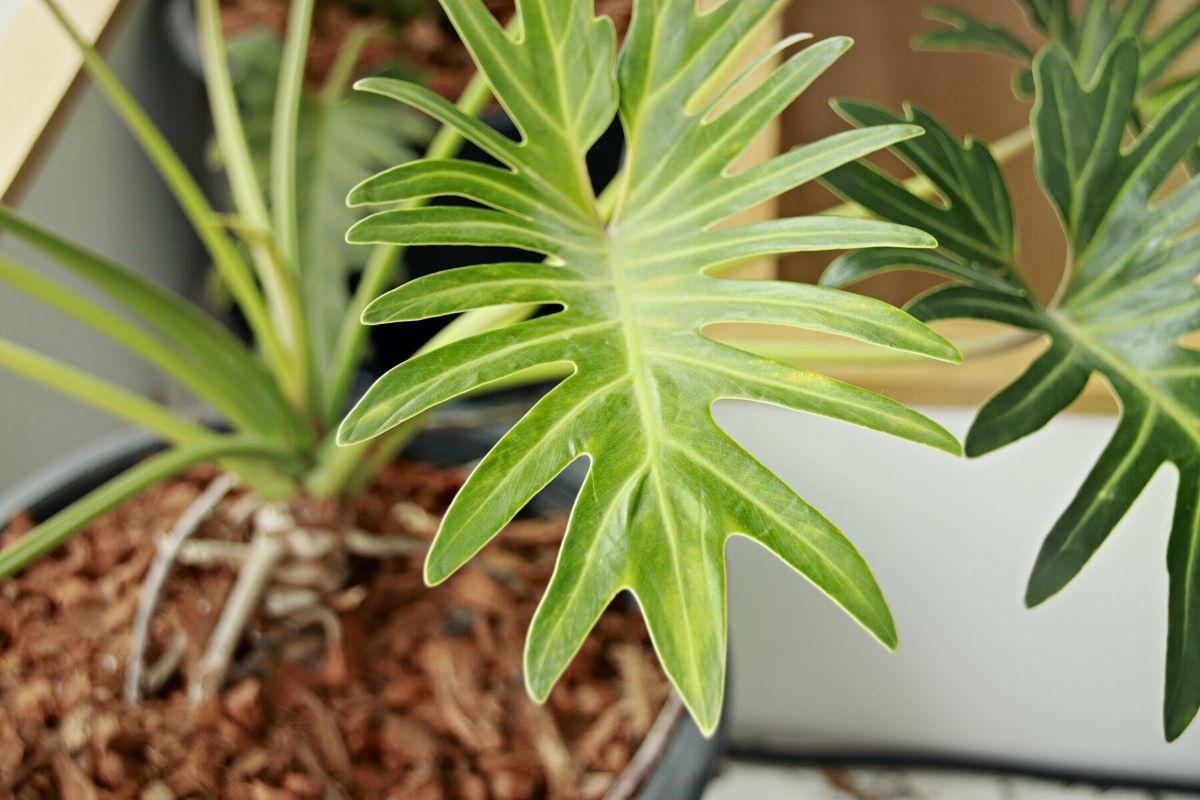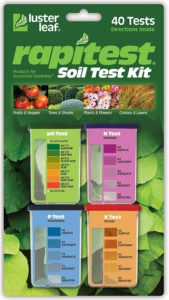Are you the proud owner of a split-leaf philodendron, yet concerned by a recent bout of yellowing leaves? Commonly confused with monstera deliciosa yet equally as loveable, split-leaf philodendrons are fast-growing, easy-care houseplants famous for sprouting vibrant little flutes of new leaves every few weeks when cared for properly.
Watching those gorgeous leaves turn yellow can induce panic in any plant parent, especially if you don’t know the cause.
If this is you and your beloved Philly, don’t panic!
Check out our split-leaf philodendron care guide for starters. If you’re up to speed on the basics, this guide will help you determine exactly what’s causing your philodendron’s leaves to turn yellow and what you can do to restore your plant to full health. In addition, you’ll learn a few tips and tricks for giving this jungle-dweller the care it needs to avoid discoloration in the future.
Split-leaf philodendron: yellow leaves
There are a surprising number of causes for yellowing leaves in non-deciduous plants. So before you decide how to remedy your split-leaf philodendron’s yellow leaves, you need to do some investigation and figure out what’s causing the discoloration.
While some yellow leaves on a philodendron are a natural part of the plant’s growth cycle, others may be cause for alarm. Some of the possible causes for yellowing leaves include normal shedding and regrowth, over- or underwatering, inadequate environmental conditions, pest infestation, root rot, and malnutrition.
Here’s what you need to know about each of these problems:
1. Normal shedding and regrowth
As with most plants, the split-leaf philodendron occasionally has to shed leaves before it can grow more. A plant only has so much energy to put into growth, and sustaining old, damaged leaves takes precious energy away from growing new ones.
Before looking for fixes to your philodendron’s yellow leaves, examine the plant as a whole. If most of the yellowing leaves are near the bottom tier of foliage and it’s otherwise thriving, the chances are that the yellowing is part of the natural growth cycle of your plant.
The Fix
Take a deep breath! Have patience and allow your beloved split-leaf philodendron to go through its natural leaf-drop phase. A good rule of thumb from our experts is: “if it’s still green, it’s still alive.” Once the old leaves have shed, your plant will resume growing healthy green foliage. It may grow even more quickly once shedding decayed foliage!
“If it’s still green, it’s still alive.”
Fellip Gallegos, Plant Enthusiast and Store Associate at Planted by Christy
2. Over- or underwatering
While some plants can tolerate over- or underwatering, split-leaf philodendrons are rather particular about their watering needs. Excess water can cause your philly’s leaves to yellow. If unchecked, yellow leaves may even develop brown spots and become soft and mushy (think old banana). If you continue to overwater your split-leaf philodendron, root rot will set in and yellowing leaves will be the least of your worries!
A thirsty philodendron can turn yellow, too, though. Underwatering can cause the plant’s leaves first to turn yellow, then brown, and eventually fall off altogether. So how can you tell the difference between an overwatered philodendron and an underwatered philodendron? Underwatered philodendrons will produce wilted and thin leaves, while overwatered philodendrons will exhibit swollen and mushy leaves.
The Fix
Determining whether your philodendron has been over- or under watered is relatively straightforward.
Underwatered Split-Leaf Philodendron
Warning Sign: Your plant’s leaves are crispy and the soil is dry.
- Saturate your plant with water, preferably by watering from the drainage tray or placing the plant in your kitchen sink, filled with 2 inches of water
- Allow excess water to drain completely
Overwatered Split-Leaf Philodendron
Warning Sign: Your plant’s leaves are yellow (moderate overwatering), brown and mushy (severe overwatering), and the soil is saturated in water.
- For mild to moderate overwaterings, simply leave your plant alone and allow excess moisture to evaporate from the soil
- For moderate to severe overwaterings, repot your split-leaf philodendron with fresh soil. Check for root rot and trim away any decaying, soggy roots before transplanting your philodendron.
- In the future, only water when the soil is dry to 2-inches
3. Low humidity
Philodendrons enjoy high humidity, usually around 60 to 70 percent. If your split-leaf philodendron’s yellow leaves are dry, the humidity in your room may be part of the problem.
The Fix
If you suspect low humidity is contributing to your plant’s suffering, try misting your split-leaf philodendron’s leaves once or twice a day. If the leaves perk up from the added moisture, invest in a room humidifier to boost the moisture level in the air to save you from so much misting.
4. Too much or too little light
Never forget that light is food for your beloved plant friends! Split-leaf philodendrons prefer bright, indirect light indoors and partial shade outdoors. Yellowing leaves may be a sign of malnutrition – i.e. your philly isn’t getting enough light. Another sign that your plant is receiving insufficient light is that its leaf tips will die and get crispy.
Reddit’s plant clinic suggests that while overwatering can cause yellow patches, too much direct sunlight can cause brown patches.
On the other hand, too much light exposure can be a problem as well. If you see your philly’s leaves turning yellow and developing sunburned patches, it’s probably getting too much sun.
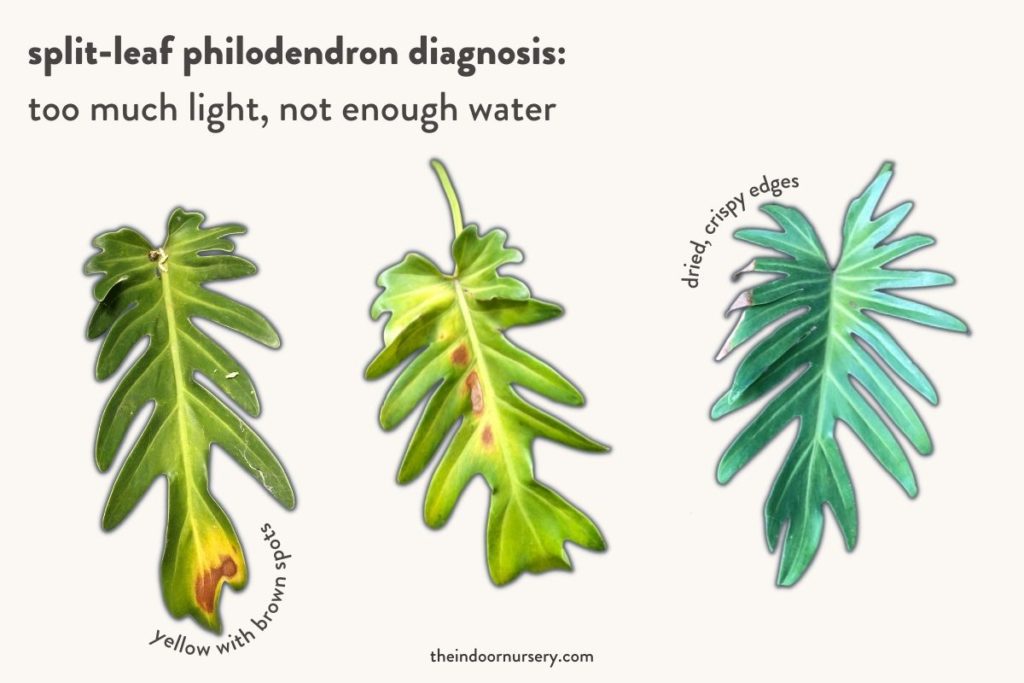
The Fix
If your philodendron’s leaves are yellow and the leaf tips are crispy, your philodendron needs more bright light. Move it closer to a window, but not so close that it gets direct sunlight all day. If it has sunburned spots, move it further away, or hang a sheer curtain in the window to protect it.
You can also use an indoor grow light to control the light your philodendron receives if your space doesn’t have sufficient natural lighting conditions, or if the light in your environment changes dramatically throughout the year. Don’t be afraid to experiment with various pot placements to see where your philly thrives.
5. Pests
Insect and other pest infestations are common in indoor plants, and the split-leaf philodendron is no exception. Common pests like aphids, spider mites, mealybugs, and scale can munch on your plants, sucking the moisture out of its leaves and turning them yellow.
If you suspect pests are plaguing your plant, look for yellowing around the edges of the affected leaves and spots where the bugs may have had a nibble. Spider mites weave nearly invisible webs that you can see if you mist them lightly with water.
The Fix
Pests can affect your plant in a variety of ways that may not always be obvious, and it follows that different pests require different solutions. Spraying your plant with a weak mixture of white vinegar and water is an effective way to prevent infestations and eliminate minor pest problems naturally. Mixing a teaspoon of neem oil with a gallon of water and pouring it into the plant’s soil can also ward off hungry bugs.
6. Root rot
Severe or chronic overwatering can lead to a condition called Pythium root rot in split-leaf philodendrons. This fungus can stunt your plant’s growth, cause its leaves to wilt, and even kill your plant if left untreated. If your plant is headed towards death by root-rot, your philodendron’s leaves will turn yellow and then brown but won’t fall from the plant as occurs during seasonal shedding.
To be sure root rot is the cause of your plant’s suffering, dig up a bit of soil to expose your plant’s roots. If they’re brown or black, mushy, or tender and “peely”, you’ve got a case of root rot on your hands.
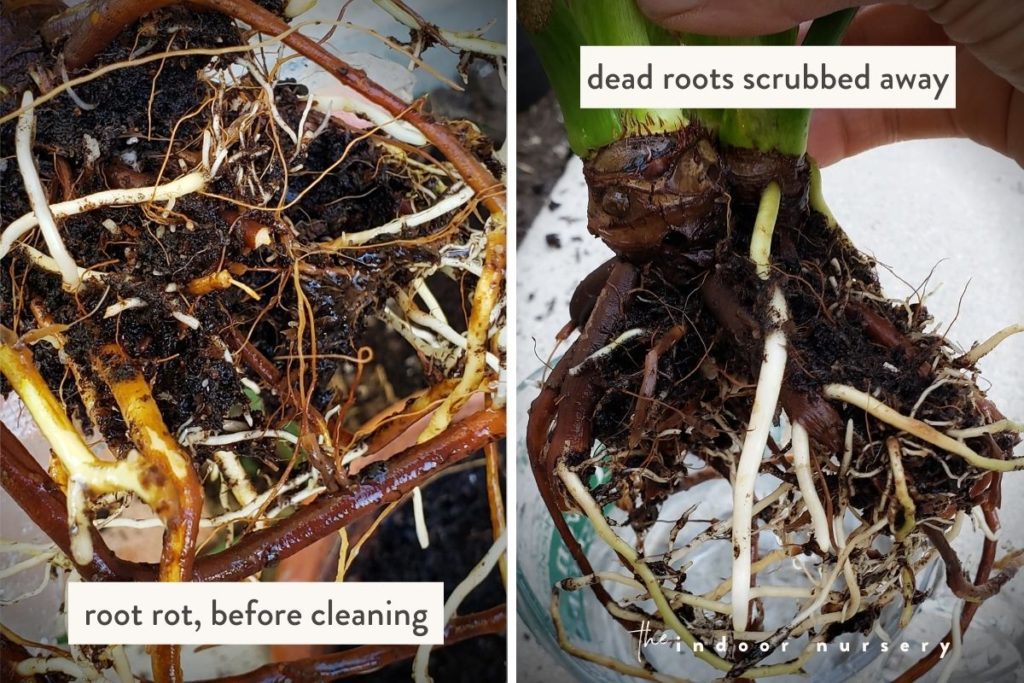
The Fix
It is possible to fix root rot if you catch the situation early enough! You can try to save your philodendron by digging it up and discarding the soil. Rinse the roots in fresh water and trim off any that are brown, black, or mushy. Repot your plant with fresh, well-draining soil to prevent further damage.
7. Poor soil nutrition
Philodendron leaves turning yellow may be caused by chlorosis, which causes yellowing leaves. A nutrient deficiency in the soil causes this condition. If the culprit is chlorosis, you’ll see v-shaped yellow patterns forming along the veins of your philodendron’s leaves.
The Fix
Supplement your soil’s magnesium content by mixing a teaspoon of Epsom salts (magnesium sulfate) into a gallon of water. Don’t get too splashy with this supplement! Water only as needed – don’t drench the soil. If yellowing continues, the soil may be low in iron. You can supplement iron deficiency in soil with a store-bought fertilizer like Ironite.
Expert tip: I highly recommend that you use a soil tester before applying any fertilizer or salts to your plant, this way you can know for certain where your plant stands before affecting its pH or nutrient balance.
Caring for your split-leaf philodendron
Prevention is always better than cure when it comes to caring for houseplants. Most of the problems covered in this article can be avoided by proper, attentive care. Once you resolve whatever’s causing your plant’s leaves to yellow, you can prevent it from happening again if you’re careful.
Like most houseplants, your split-leaf philodendron plant will be happiest and healthiest if you offer it conditions most similar to those in its natural habitat. Tropical plants like phillies prefer warm, tropical conditions. Here’s are a few tips to help your split-leaf philodendron thrive:
Potting needs
Split-leaf philodendrons generally prefer a peaty, soil-based potting mix. An expert we interviewed recommends mixing your own potting mix for philodendrons. Their tall leaves tend to fall over or grow horizontally without support or pruning, so give them a trellis or stake to climb.
They require repotting every year or so to avoid becoming rootbound, which they hate. If you prefer to keep your plant in the original pot size but can’t bear to cut it back, propagate the philodendron cuttings you prune away and grow them in vases.
Regular watering
As you already know, split-leaf philodendrons can be rather tricky when it comes to their water requirements. Overwatering is a recipe for disaster, as it can waterlog your plant and potentially cause root rot.
On the other hand, underwatering can cause your plant to grow more slowly than it otherwise would or even cause it to wilt and die. It’s important that you find the right watering routine to avoid over- or underwatering your philodendron.
When you do water, use the right size watering can and be sure to saturate your plant’s soil thoroughly. To do this, water your philly from the bottom (pouring water into your pot tray, or setting your plant in a sink with the outer-pot removed to water) until the top of the soil is wet, or from the top until water comes out of the drainage holes in the bottom. Allow the soil to dry out some between waterings, but not completely.
Once you figure out how much and how often to water your split-leaf philodendron, make it a regular routine instead of relying on guesswork. Don’t forget to reduce your watering schedule in the fall and winter when light is scarce and your plant’s growth slows.
Bright indirect light
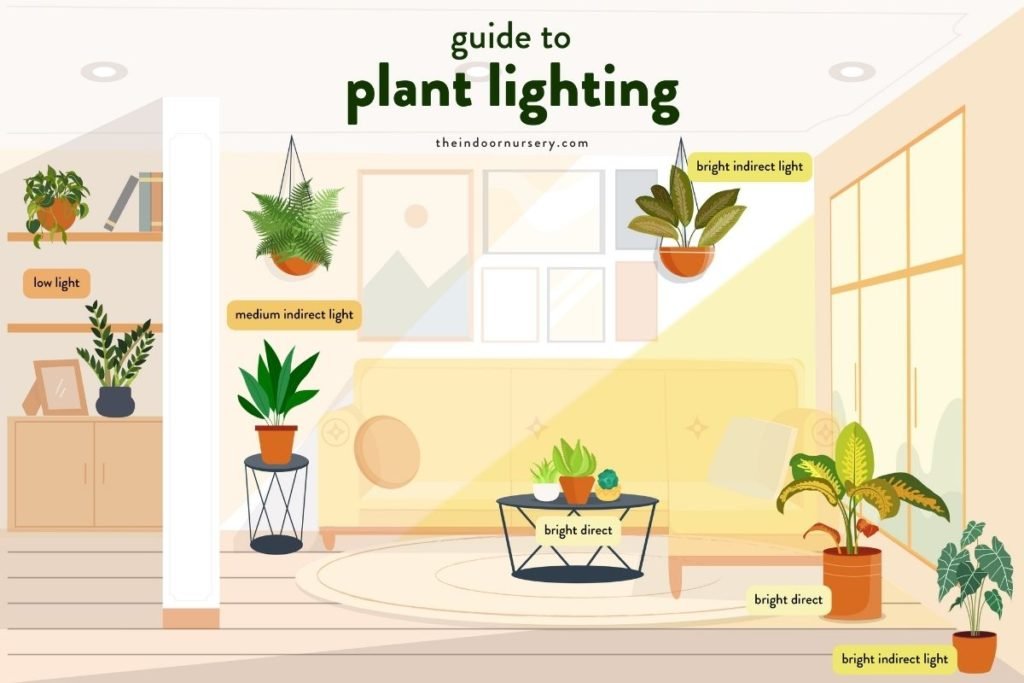
Indoor split-leaf philodendrons like bright, indirect sunlight. Try placing your plant in front of a big window with a sheer curtain or just outside the sunbeam of an unshaded window. Too little sun can cause new leaves to grow without their characteristic perforations, and too much direct sunlight can cause sunburn. Adjust as needed from one season to the next.
Regular fertilization
Never fertilize a plant that already appears unhealthy. If your philodendron’s leaves are still yellow, hold off on fertilizing. Once you’ve resolved the issue and your plant is thriving again, start or resume fertilizing it regularly from spring to fall.
More about philodendrons
- 13 Different Types of Philodendron Plants For Jungle Vibes
- Philodendron Brasil Care Guide
- Split Leaf Philodendron Care Guide
- Growing Philodendron Micans Care Guide
- How to Propagate a Split-Leaf Philodendron: Easy Step-by-Step Guide
- Growing pink princess philodendron: How to grow them and keep them happy
- How to care for a philodendron (for beginners): An expert reveals secrets

